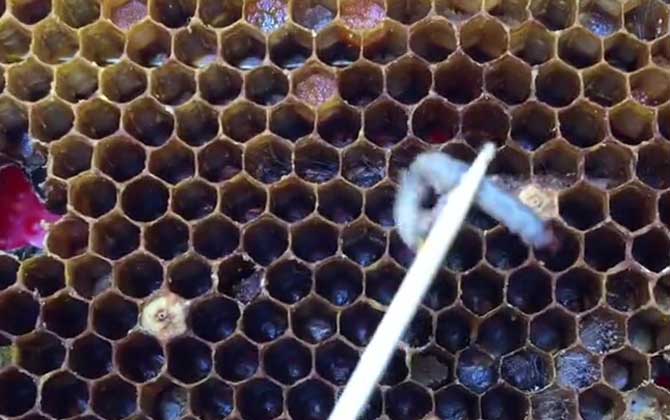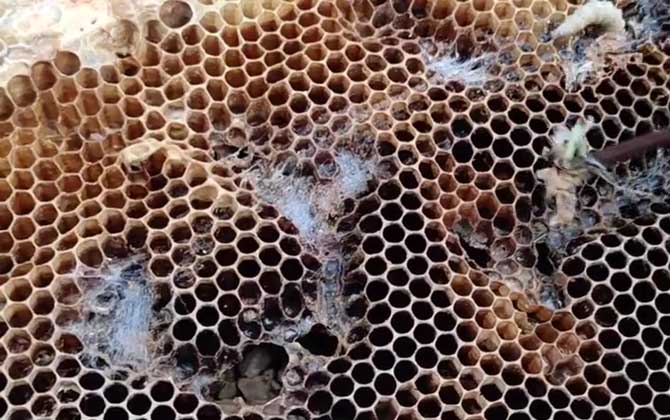Wax Moths: Destructive Pests in Beehives
Wax moths (Galleria mellonella and Achroia grisella) pose significant threats to honeybee colonies worldwide. As larvae of wax moths, these pests not only damage honeycombs by consuming beeswax but also destroy bee larvae and pupae. Mild infestations reduce honey production, while severe cases can force entire colonies to abandon their hives. Below we explore comprehensive control methods for these destructive insects.

Figure 1: Wax moth larvae infesting honeycomb cells
I. Life Cycle and Damage Process
Stage 1: Infiltration (March-April)
- Nocturnal mating: Female moths mate with males at night when bee colonies are less vigilant
- Egg deposition: Post-mating females lay 300-600 eggs in hive crevices or wax debris (optimal temperature: 29-35°C)
- Camouflage: Eggs blend with wax particles due to similar coloration
Stage 2: Larval Development (8-23 days)
- Mobile hatchlings: Newly emerged larvae measure 1-2mm with high mobility
- Migration pattern: Larvae gradually move upward from hive bottom to combs
- Initial tolerance: Worker bees initially ignore early-stage larvae
Stage 3: Colony Destruction
- Comb destruction: Larvae create silk-lined tunnels through wax structures
- Secondary damage: Weakened combs collapse, destroying brood and food stores
- Colony collapse: Weak colonies (<20,000 bees) often abandon hives when ≥30% comb destruction occurs

Figure 2: Severe honeycomb damage caused by wax moth larvae
II. Integrated Pest Management Strategies
1. Hive Maintenance
- Weekly wax removal: Clean all debris using hive tools with ≥70° angled blades
- Comb rotation: Replace 30% of old combs annually (dark combs attract more moths)
- Physical barriers: Install 3mm mesh screens at hive entrances
2. Colony Strengthening Techniques
- Optimal population: Maintain colonies with ≥50,000 worker bees
- Queen management: Replace queens every 12-18 months to maintain brood viability
- Feeding protocol: Use 1:1 sugar syrup with 0.2% probiotic supplements during dearth periods
3. Chemical Controls
| Treatment | Application | Efficacy |
|---|---|---|
| Para-dichlorobenzene crystals | 5g/10L hive volume | 95% larval mortality |
| Bacillus thuringiensis spray | 0.5% solution | 87% suppression |

Figure 3: Applying biological controls in modern apiculture
III. Traditional Control Methods
1. Neem-based Bait (Azadirachta indica)
- Preparation: Boil 1kg neem bark with 2L water for 45 minutes
- Application: Mix concentrate with rice bran (1:3 ratio)
- Effectiveness: Shows 78% larval reduction within 72 hours
2. Sulfur Fumigation Protocol
- Safety note: Requires proper ventilation
- Procedure: Burn 10g sulfur powder per hive body
- Limitation: Doesn’t affect eggs (requires repeat treatment)
3. Thermal Control Methods
- Freezing: Exposure at -10°C for 48 hours kills all life stages
- Heat treatment: 46°C for 4 hours eliminates moths
- Solar sterilization: 6 hours direct sunlight disinfects empty equipment
Modern beekeeping combines traditional wisdom with scientific approaches for effective wax moth control. Regular monitoring using pheromone traps (capturing 15-20 moths/week indicates need for action) and maintaining strong colonies remain the cornerstone of successful prevention. Always remember – prevention yields better results than treatment in hive management.